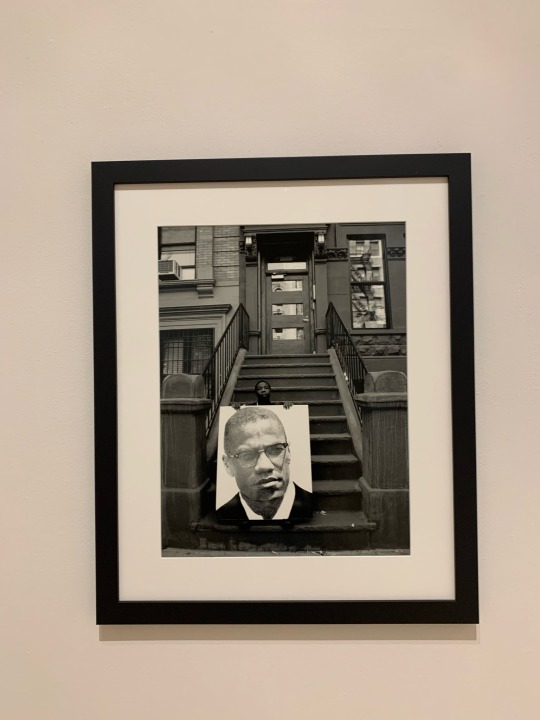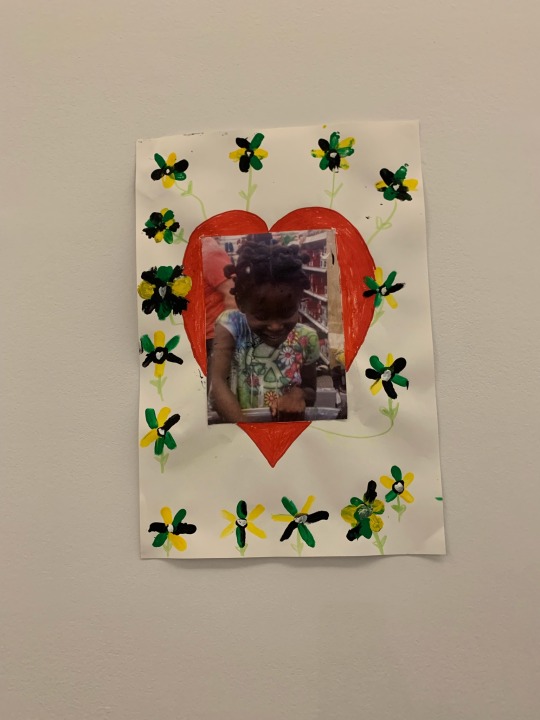Text
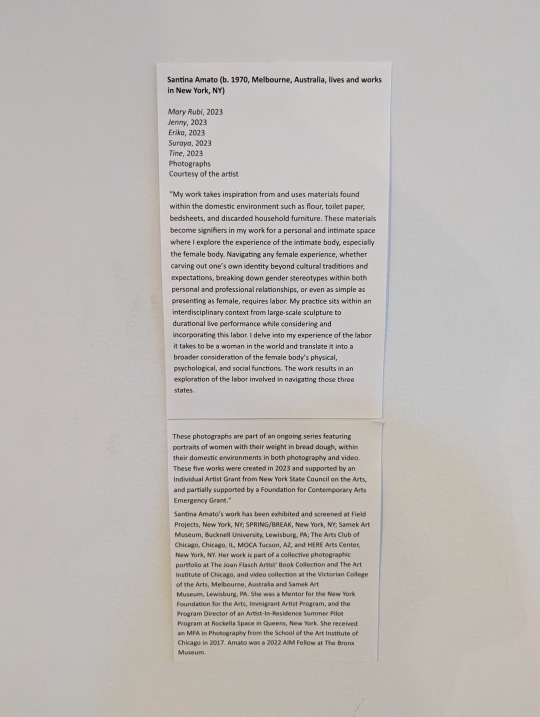
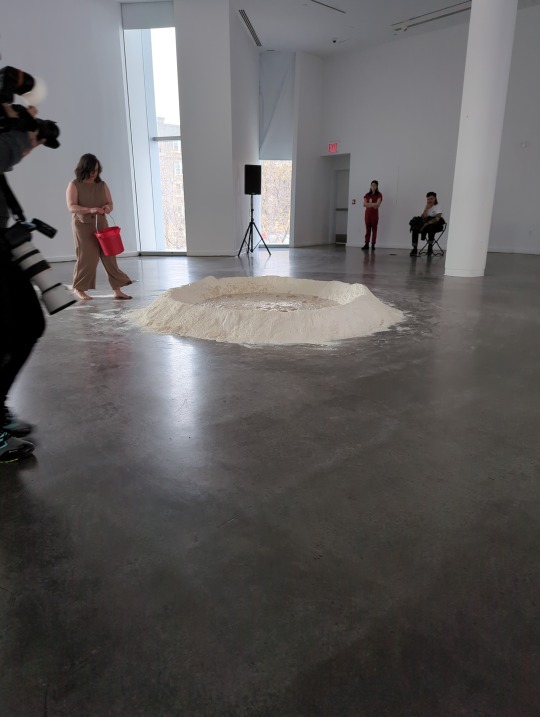
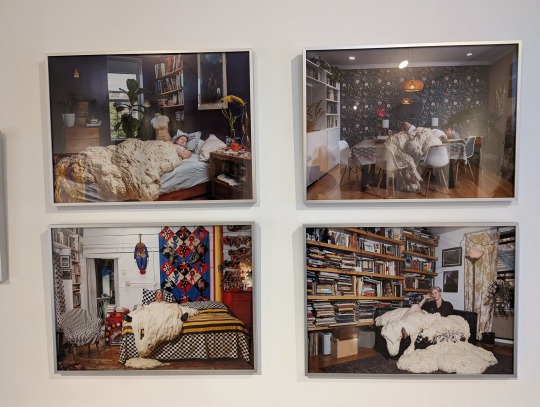
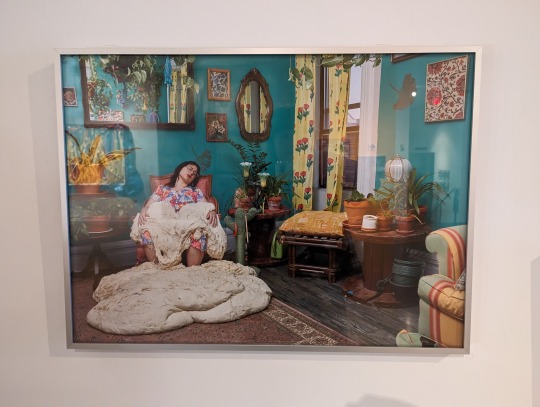
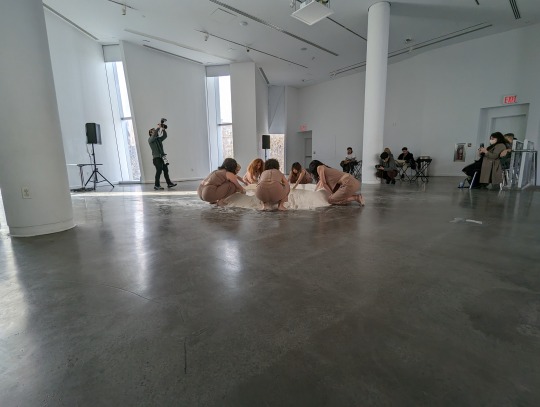

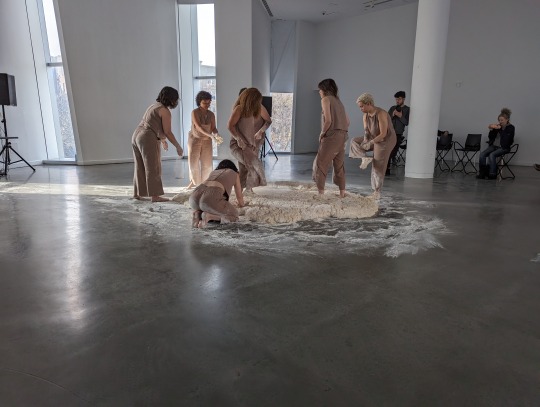
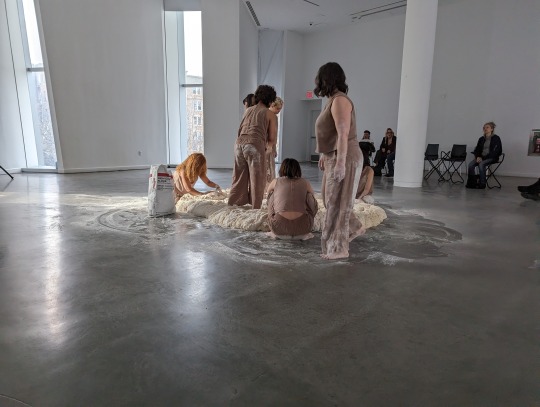

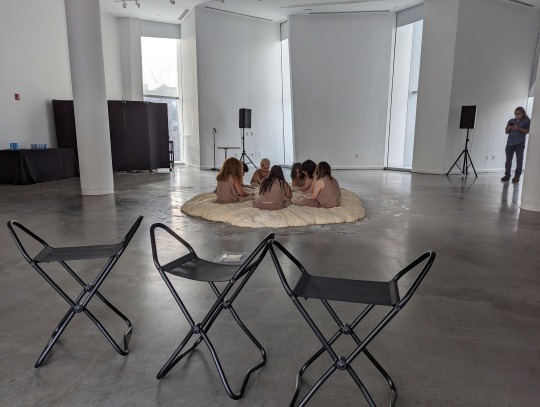


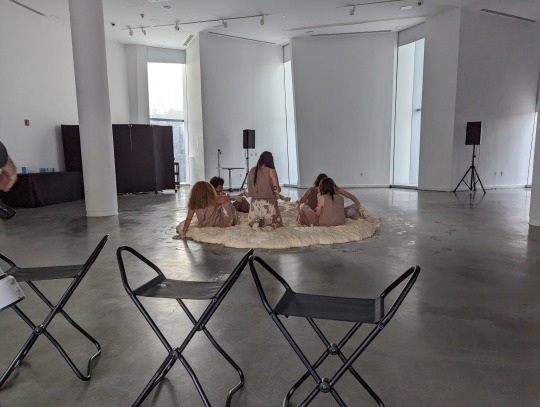
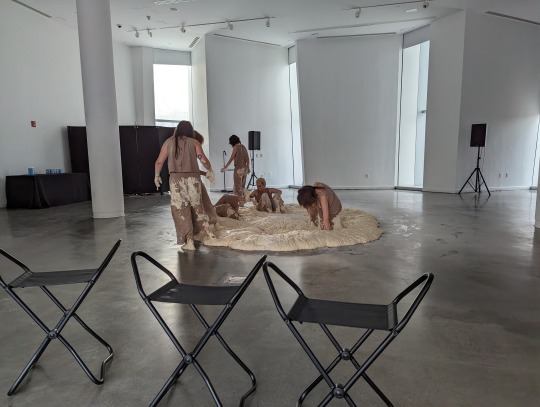
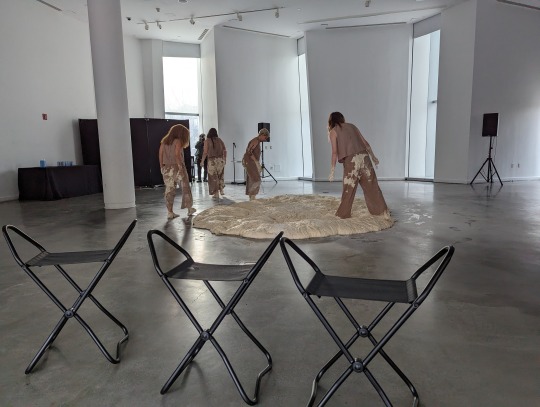
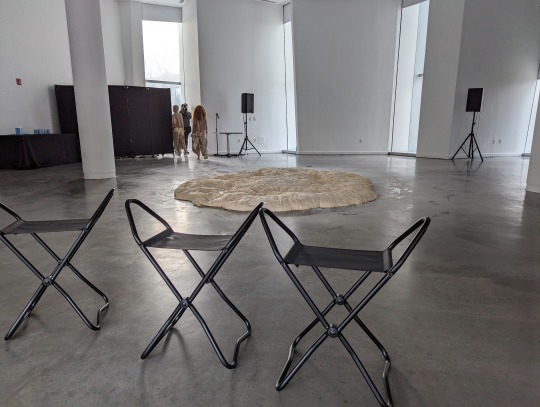
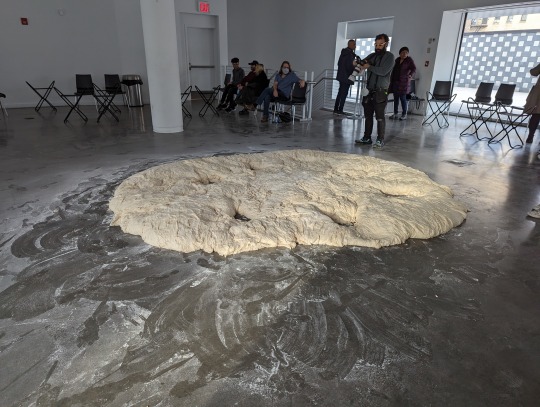
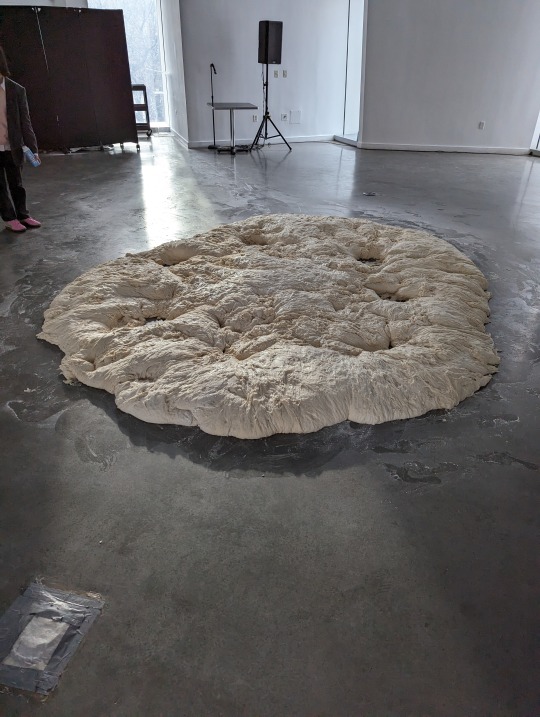
'Flowers Will Die: A live performance by Artist Santina Amato' 3:30–6PM On the 2nd Floor
She describes the 'Flowers Will Die: A live performance by Artist Santina Amato' activation of her work in 'The Biennial' as follows:
"'Flowers Will Die' is a performance using bread dough, a signature material in Amato’s work. Within the live setting, dough creates a visceral experience where the comforting smell of bread dough consumes the audience’s sense of smell.
"'Flowers Will Die' sees Amato and six other women labour in the creation of 2-300 lbs of dough. Once the flour, water, and yeast has been labored over to form the dough, each woman carries as much of this ephemeral material from its place of creation to its place of activation and eventual death.
"A circle of women sitting in waiting will receive the dough. Once all the dough is deposited within the embrace of the women, the audience watches as the dough activates the sculpture they have created with their bodies, rising and consuming their limbs and bodies over a slow period of an hour and a half.
"The audience is encouraged to meander the museum while the activation is in process, returning to the room to see the sculpture’s slow morph.
"Amato’s work with bread dough stems from a cultural history of women’s labour within the domestic environment that was passed down through the women before her. Raised in Australia by immigrant poor rural workers from the south of Italy who themselves were raised during the depression era and fascist Italy, Amato was raised to see labour as way to fully experience the human condition. Being raised in a multicultural society, it was only when Amato entered adulthood, specifically womanhood, that the realization that the labour women are asked to carry is more than just physical. Her live performances play out the physical and psychological labour women are still expected to carry."
part of the Closing Event: 6th AIM Biennial Featuring AIM Fellow Activations • Saturday, March 30, 2024 • 1–6PM
1 note
·
View note
Text
Michener Art Museum
Grace, our spotlight blogger, shines her spotlight on the Michener Art Museum in Doylestown PA and their current exhibition featuring Bronx native Alan Goldstein and his magnificent show, Elemental. #MarywoodArt #PAArts
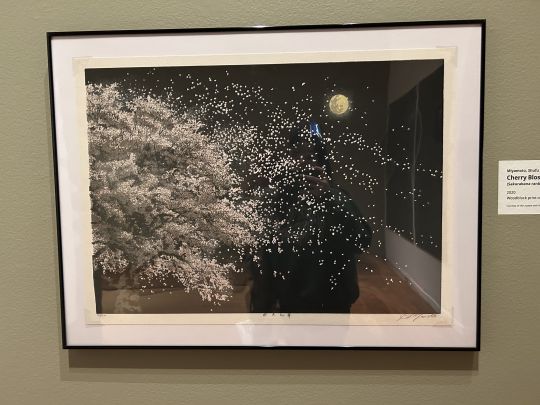
View On WordPress
#Alan Goldstein#Art#Art History#bronx#Bucks County#Carversville#doylestown#elemental#Illustration#japonisme#manga#Marywood Art Department#Marywood University#Michener Art Museum#mid-century#modern japanese print#New York City#PA#Painting#Pennsylvania#teacher
3 notes
·
View notes
Text
I was meeting a client at a famous museum’s lounge for lunch (fancy, I know) and had an hour to kill afterwards so I joined the first random docent tour I could find. The woman who took us around was a great-grandmother from the Bronx “back when that was nothing to brag about” and she was doing a talk on alternative mediums within art.
What I thought that meant: telling us about unique sculpture materials and paint mixtures.
What that actually meant: an 84yo woman gingerly holding a beautifully beaded and embroidered dress (apparently from Ukraine and at least 200 years old) and, with tears in her eyes, showing how each individual thread was spun by hand and weaved into place on a cottage floor loom, with bright blue silk embroidery thread and hand-blown beads intricately piercing the work of other labor for days upon days, as the labor of a dozen talented people came together to make something so beautiful for a village girl’s wedding day.
What it also meant: in 1948, a young girl lived in a cramped tenement-like third floor apartment in Manhattan, with a father who had just joined them after not having been allowed to escape through Poland with his pregnant wife nine years earlier. She sits in her father’s lap and watches with wide, quiet eyes as her mother’s deft hands fly across fabric with bright blue silk thread (echoing hands from over a century years earlier). Thread that her mother had salvaged from white embroidery scraps at the tailor’s shop where she worked and spent the last few days carefully dying in the kitchen sink and drying on the roof.
The dress is in the traditional Hungarian fashion and is folded across her mother’s lap: her mother doesn’t had a pattern, but she doesn’t need one to make her daughter’s dress for the fifth grade dance. The dress would end up differing significantly from the pure white, petticoated first communion dresses worn by her daughter’s majority-Catholic classmates, but the young girl would love it all the more for its uniqueness and bright blue thread.
And now, that same young girl (and maybe also the villager from 19th century Ukraine) stands in front of us, trying not to clutch the old fabric too hard as her voice shakes with the emotion of all the love and humanity that is poured into the labor of art. The village girl and the girl in the Bronx were very different people: different centuries, different religions, different ages, and different continents. But the love in the stitches and beads on their dresses was the same. And she tells us that when we look at the labor of art, we don’t just see the work to create that piece - we see the labor of our own creations and the creations of others for us, and the value in something so seemingly frivolous.
But, maybe more importantly, she says that we only admire this piece in a museum because it happened to survive the love of the wearer and those who owned it afterwards, but there have been quite literally billions of small, quiet works of art in billions of small, quiet homes all over the world, for millennia. That your grandmother’s quilt is used as a picnic blanket just as Van Gogh’s works hung in his poor friends’ hallways. That your father’s hand-painted model plane sets are displayed in your parents’ livingroom as Grecian vases are displayed in museums. That your older sister’s engineering drawings in a steady, fine-lined hand are akin to Da Vinci’s scribbles of flying machines.
I don’t think there’s any dramatic conclusions to be drawn from these thoughts - they’ve been echoed by thousands of other people across the centuries. However, if you ever feel bad for spending all of your time sewing, knitting, drawing, building lego sets, or whatever else - especially if you feel like you have to somehow monetize or show off your work online to justify your labor - please know that there’s an 84yo museum docent in the Bronx who would cry simply at the thought of you spending so much effort to quietly create something that’s beautiful to you.
#shut up e#long post#Saturday thoughts#this has been in my drafts for a week haha#also this is the heart of why AI art feels so wrong#forget the discussion of copyright and theft etc - even if models were only trained on public domain they would still feel very wrong#because they’re not art. art is the labor of creation#even commercial art and art commissioned by the popes and kings of history: there is humanity in the labor of it#unrelated: I did not know living in the Bronx was now something to brag about. How the fuck do y’all New Yorkers afford this city???
28K notes
·
View notes
Text

"For my brothers with Daughters, I call This..." Whenever I think about the origin of my journey into photography, I remember the 2 main reasons for picking up a camera. One was to document the sneakers I wore daily with the intention of sharing the photos on a popular online sneaker forum called NikeTalk. The second and more important reason was to document my family. After realizing that my parents photo albums have a significant gap in photos of me and my brother, I vowed to take on the responsibility of documenting my family.

So naturally (especially in this modern world we're living in) when I became a father 10 years ago, I was reminded of that vow. There's very few people if any at all that I enjoy taking photos of more than my own daughters!


I mean, it's super obvious why, right? My babies are the most beautiful people on this planet. With smiles that melt my heart and hugs that would make a grizzly bear jealous. Lol. I've made it my business to get millions of photos of them not only on film but on my phone and digital cameras as well.


I've been a photographer for 15 years now! In that time I've gotten a large sum of photos of my family and the ones of my babies are easily my favorite. I tend not to share photos of them too often because I see them as treasures that should be protected at all cost. So I say that to say, this post is being made with the intention of giving you, the reader a treat! Lol

It was 2015 when I first picked up an analog camera. Six years after deciding I wanted to be a photographer. At the time my oldest was a curious 1 year old. It's been an honor to watch her grow into the lovely young woman she is becoming.

The youngest (the leader of our pack) wasn't even thought of yet, but she caught up and became manager of the family very quickly. Lmao.
Some of my photos are blurry, and some were exposed wrong, but that's ok! At the very least I know I have the memories of my children in my head. These prints that accompany my thoughts are just a bonus!!

Hope ya Enjoy! Eno Bull Photography
#Kids#Girls#Playtime#Adidas#Sneakers#NikeTalk#My Babies#Babies#Baby#BackPack#School Kids#Museum#Art#Glasses#photographer#photography#nyc#fashion#model#portrait#eno bull photography#street photography#my photos#photooftheday#new york#the bronx#Philly#Philadelphia#Sisters#Best Friends
1 note
·
View note
Text
Deco Doings - November, 2023
Autumn by William Welsh, 1930. Image from Pinterest. Here is a list of some wonderful Art Deco Events happening this November to enjoy. Metropolitan Museum of Art Art for the Millions: American Culture and Politics in the 1930s (In Person Event) Thursday, September 7 – Sunday, December 10, 2023, Metropolitan Museum of Art, 1000 Fifth Avenue, New York, NY Poster House Art Deco:…

View On WordPress
#Art Deco Posters#Art Deco Society of New York#Art Deco Society of the UK#Art Deco Society of Washington#Art for the Millions#Australian Art Deco Hotels#Chicago Art Deco Society#Connecticut Avenue#Detroit Area Art Deco Society#Detroit Wallpaper Company#Jamaica Queens#Metropolitan Museum of Art#New York Adventure Club#Poster House#The Brill Building#The Bronx#Tortoise Supper Club
0 notes
Text
"New York City officials have agreed to restore more than $111 million in funding to libraries and cultural institutions, the City Council announced Thursday [June 27, 2024].
The agreement is a victory for residents and organizations who had been pushing back for months against budget cuts in the nation’s largest city and one of the world’s foremost cultural capitals.
In November, the city announced it would cut the budget of the New York Public libraries by $58.3 million in fiscal year 2025, and slash the budget for other cultural institutions, including the Bronx Zoo and Carnegie Hall, by $53 million. The new deal reverses those cuts, and is set to be finalized in a City Council vote Sunday...
“Our arts and cultural institutions and libraries are foundational pillars of our city, and New Yorkers depend on their services every day,” said New York City Council Speaker Adrienne Adams, thanking the mayor’s administration for reaching the deal. “The Council has consistently championed funding restorations for these institutions as a top priority, and we’re proud to reach an agreement with Mayor Adams and the administration to successfully secure these critical investments for them in the city budget.”
The news was received with collective approval from New York institutions that had been forced to cut hours and public access due to lack of funding.
“The Museum of the City of New York is delighted to learn of the restoration of cuts to the cultural sector,” the museum’s president Stephanie Hill Wilchfort told CNN in a statement.
“This support makes it possible for MCNY to be open seven days a week, starting on July 1,” said Wilchfort, who serves as Executive Vice Chair of the Cultural Institutions Group, a coalition of 34 non-profit organizations such as the city’s museums, gardens, and arts centers. “As such, the Museum’s exhibitions exploring history, popular culture, and art will be open to the public on Tuesdays and Wednesdays for the first time since the pandemic. City support also allows the Museum to operate as a cooling center, open at no charge to anyone who seeks relief from warm weather.”
The city’s three public library systems — New York, Queens, and Brooklyn — issued a joint statement thanking the administration, the city council and New York residents, who overwhelmingly supported the campaign to restore library budgets. More than 174,000 people sent letters to City Hall in support of the “No Cuts to Libraries!” campaign since the cuts were announced in November [2023].
“This funding will allow us to resume seven-day service, a priority for many New Yorkers,” the libraries said in a statement shared with CNN. “We expect that service to begin in the coming weeks, bringing our branches back to the same hours of operation prior to the November 2023 cuts. The funding also allows us to continue universal six-day service, which New Yorkers have enjoyed for nearly a decade.”
-via CNN, June 28, 2024
685 notes
·
View notes
Text

Paula Nadelstern, Kaleidoscopic XVI: More Is More
Bronx, New York
1996
Cottons and silk
64 x 64"
Collection American Folk Art Museum, New York
Gift of the artist, 2008.21.1
Photo by Karen Bell
217 notes
·
View notes
Note
fave things about nyc?
Other than all of the art and history museums?
I miss going to Chinatown for $25 blowouts, $75 for a French full set with gel polish and a pedicure, $60 lash extensions, $10 brow threading, and great food. I spent hours meandering around, looking for deals, trying new things, and having such a good time with my girlfriends. Chinatown and the Bronx are two of my favorite neighborhoods to go for culture, beauty services, food, and entertainment.
Go try the Mario Badescu Spa in Midtown for the best $65 facial you’ve ever had. I’d go once or twice every month, leave with tons of samples and much brighter skin, and I always felt like I was being cared for. Are there cheaper places to get facials in the city? Sure, but the service is amazing, the sanitation is pristine, they don’t bother you or try to sell you all of Mario’s products, they work with skin of all colors, and you get your money’s worth during your session.
If you want sewing done, you go to the Garment District and then down to Little Saigon. One of my favorite things to do was collect inspiration online, buy fabric, and then take it to the old man who basically made my closet. I’d print out a photo of what I wanted, stand for him to take my measurements, and he’d whip it up in a week flat. Everything he made me is beautiful; the buttons are straight, the seams are beautiful, and they don’t show wear or tear. Your affordable laundering and sewing services are going to be in Little Saigon, and I’d recommend having a variety of pieces made for yourself.
Controversial opinion here, but the Hasidic restaurants are 100% worth going to, even if they seem closed off or inaccessible. I’ve been to a few restaurants with old plastic menus with photos and descriptions written entirely in Yiddish, pointed at what looks good, and then eaten the meal of my life. If you’re going to a spot that’s in an entirely Hasidic neighborhood, you might get weird looks, but it’s 100% safe, and the food is always lovely. I’d avoid going during the Jewish holidays or Shabbos, but any other time during the week should be fine.
One of the best things a girl can do for herself is go dancing. Whether that means going to bachata or salsa, going to a gay club, dropping in on one of those good ballet classes in Harlem, or going to Jazz night in the meatpacking district, you’ve got to take yourself dancing. I think that going dancing is an integral part of life and a hobby that every girl should have. You don’t need to drink or spend too much to dance, and you can find a type of dance you enjoy and do it forever. Make a friend, find a club, choose a Friday, and go dance.
I could talk about NYC and all I’ve experienced forever.
39 notes
·
View notes
Text

4 notes
·
View notes
Photo

New York City
New York tumblr more photos here New York City, often simply referred to as NYC, is one of the most iconic and vibrant cities in the world. Located in the northeastern part of the United States, it is situated on the southeastern tip of the state of New York. With a population of over 8 million residents within the city limits and over 20 million in the greater metropolitan area, it is the most populous city in the United States.
Geography and Layout: New York City is composed of five boroughs: Manhattan, Brooklyn, Queens, The Bronx, and Staten Island. The city is located on a series of islands and connected by bridges and tunnels. Manhattan, the heart of the city, is where many of its most famous landmarks are located. It is divided into several neighborhoods, each with its own distinct character and atmosphere. The city is known for its impressive skyline, dominated by iconic skyscrapers like the Empire State Building, One World Trade Center (Freedom Tower), and the Chrysler Building.
Culture and Diversity: One of New York City's defining characteristics is its incredible diversity. People from all over the world have made the city their home, resulting in a rich tapestry of cultures, languages, cuisines, and traditions. This diversity is celebrated through various cultural events, festivals, and neighborhoods that showcase the heritage of different communities.
The city's cultural scene is unparalleled, with world-class museums such as the Metropolitan Museum of Art, the Museum of Modern Art (MoMA), and the American Museum of Natural History. Broadway, located in the Theater District of Manhattan, is synonymous with American theater and is famous for its top-tier productions.
Economy and Business: New York City is a global economic powerhouse. Its financial district, centered around Wall Street in Lower Manhattan, is home to some of the world's largest and most influential financial institutions. The city's economy is incredibly diverse, encompassing finance, media, technology, fashion, tourism, and more.
Education and Research: The city boasts some of the world's most prestigious universities, including Columbia University, New York University (NYU), and The City University of New York (CUNY) system. These institutions contribute to the city's reputation as a hub for research, innovation, and intellectual exchange.
Cuisine and Culinary Scene: New York City is a culinary melting pot, offering an array of dining options that reflect its multicultural makeup. From street food carts offering hot dogs and pretzels to high-end restaurants serving international cuisines, the city caters to all tastes and budgets. Iconic foods like New York-style pizza, bagels, and deli sandwiches are part of the city's culinary fabric.
Transportation: The city's extensive public transportation system, which includes the subway, buses, and ferries, is a crucial part of daily life for millions of residents and visitors. The yellow taxi cabs are also an iconic symbol of the city's transportation.
Landmarks and Attractions: New York City is home to an impressive array of landmarks and attractions. Some of the must-visit places include:
Times Square: A bustling commercial and entertainment hub known for its bright lights, theaters, and New Year's Eve celebrations.
Central Park: An expansive green oasis in the heart of Manhattan, offering a retreat from the urban hustle and bustle.
Statue of Liberty and Ellis Island: Iconic symbols of American freedom and immigration history.
Brooklyn Bridge: A historic suspension bridge connecting Manhattan and Brooklyn, offering stunning views of the city skyline.
Rockefeller Center: A complex of commercial buildings, famous for its ice-skating rink and the Top of the Rock observation deck.
The High Line: A unique elevated park built on a former railway track, offering a serene escape above the city streets.
Museums and Art Galleries: In addition to the aforementioned museums, NYC is home to the Guggenheim Museum, Whitney Museum of American Art, and more.
Challenges and Opportunities: Despite its allure, New York City also faces challenges such as high living costs, traffic congestion, and issues related to affordable housing. The city has shown resilience in the face of challenges, and initiatives are continually being developed to address these concerns and create a more equitable and sustainable future.
In summary, New York City is a dynamic and multifaceted metropolis that captivates visitors and residents alike with its cultural richness, economic vitality, and unparalleled energy. Its ability to constantly reinvent itself while honoring its history makes it a truly remarkable and enduring global city.
#New York City#new york#newyork#New-York#nyc#NY#Manhattan#urban#city#USA#United States#buildings#travel#journey#outdoors#street#architecture#visit-new-york.tumblr.com
152 notes
·
View notes
Text
E1610! Miles x Bronx! Reader
A/N: Because I don't know why we haven't thought of this yet! P.S.: I'm not a Brooklyn-native. P.P.S.: I tried my best to make this as gender-netural as possible!

Y'all most definitely argue over which borough is better. Miles, of course, proceeds to list a million and one reasons as to why Brooklyn is better.
He's fascinated by the differences in the way you two speak. He loves it when your "accent" is audible in the way you speak.
Miles tries his best to indoctrinate introduce you to Brooklyn culture. He takes you to hotspots (Coney Island is one of the first that y'all hit up), but mostly sticks to local, Brooklyn-exclusive places (i.e. his favorite pizza spot, some of his favorite places to graffiti, that one small, Black-owned business that he gets some of his favorite clothes from).
Miles most definitely loves the South Bronx better than the North due to its street culture and abundance of unique graffiti. He literally drools when he sees a beautiful mural on the wall of a bodega or deli. He goes inside and asks the owner about the artist, get said artist's name, looks them up so that he remembers, and then proceeds to go back outside and take an abundance of photos of the mural before taking the next ten minutes to study it like a museum exhibit.
If you live in the North Bronx, Miles still finds to things to love. He still goes feral for any street art that he sees, and he'll make an effort for y'all to go out on adventures where you show him and/or discover new places in your area.
If y'all go to the Bronx Zoo, Miles takes a billion pictures in front of the entrance, claiming that he has to because this is an "infamous New York location!"
His favorite Bronx stops on the train are probably Simpson Street and Prospect Avenue.
I feel like Miles's dad, Jeff, and his Uncle Aaron used to spend their adolescent years out and about on the streets of New York. They grew especially fond of the Bronx, leading to them starting to visit the borough regularly and establish friendships and connections. However, Jeff ultimately fell out with this affinity after he started attending police academy. Aaroon kept up with it, though.
^Despite his shock, pain, and grief over his uncle, Miles forced himself to go through his uncle's apartment after his death. There, he found some old-school records and mixtapes, the latter mostly by local, underground artists from across New York. Miles kept them and has them stored somewhere safe in his room (probably his closet).
^^Y'all go through the collection, listening avidly as you study the flow of each of the artists, analyze the album cover, and the artists' styles.
^^^Most of the mixtapes feature Bronx-native artists.
^^^^Miles, refusing to accept this, runs out of his room and into the living room where his parents are sitting. He begins to explain the situation and asks Jeff to tell you that Uncle Aaron loved and represented Brooklyn through-and-through.
^^^^^Jeff laughs, a bit nervously because he's always raised Miles to take pride in where he's from (yes, the borough representation is real, people). He then explains that, yes, while Uncle Aaron loved Brooklyn, he loved the Bronx almost, if not just as much. He loved traveling to and from, made a lot of good friends and connections there. The Bronx is also where a few of his greatest and most memorable "honeys" are from.
^^^^^^Okay, I know that this is supposed to be a Miles Morales headcanon, but: when he wasn't out, working as the Prowler, Aaron was actually "away from a few days" as he says in his voicemail. He would travel to the Bronx to hang out and see friends. He was actually pretty well-known in some parts of the borough.
^^^^^^^Before his death, Aaron was serious relationship with a woman from the Bronx. Despite them seeing each other steadily for a year or four, he didn't tell Miles because he didn't want to introduce to him to someone that he would love, care for, and cherish, only to have it go up in flames. He most definitely gushed about her to Jeff and Rio on the down-low, though.
^^^^^^^^Aaron also thought about moving in with her and even marrying her more than once. Major Jabari x Meadow vibes.
^^^^^^^^^Uncle Aaron looking down at Miles with a smile because he's taking after his uncle.
^^^^^^^^^^"'Dem Bronx folk, man. They'll do that to 'ya."
If You Attend Visions Academy:
If you attend Brooklyn Visions, Miles texts you from the moment that he wakes up in order to make sure that you wake up with enough time to comfortably do your morning routine, get ready, and catch your train(s) with added flexibility in case of train delays.
^He never used to wake up early before, but he doesn't want you to be late. Not that it's a big deal (Miles has been late more times than he can count) but he doesn't want you to have frequent lateness on your record. Plus, the earlier you get there, the more time you two have to talk and prep for the upcoming day.
Often asks if you feel homesick. He can't imagine how it must feel. He only lives a few blocks away and yet he feels so far from home (hehe, get it?).
^^Does his best to make you feel accustomed to Brooklyn. He makes it a point to take you out and show you around so that you develop a sense of familiarity and don't feel out of place or lost.
If someone says that Brooklyn is the better borough, Miles will occasionally chime in with a reason or two as to why the Bronx is superior.
^You owe him a Brooklyn-based adventure after this, though.
^^If y'all are dating, you owe him kisses and cuddle-session in addition to a Brooklyn-based adventure.
Best believe that he's at the train station with you ever Friday and Sunday, helping you lug your suitcase and additional bags to and from Visions.
If You Don't Attend Vision Academy:
Y'all video call regularly to discuss your respective days as well as plan an in-person meet-up.
Y'all often meet-up in Manhattan because neither one wants to give the other the satisfaction of traveling to their respective borough for your meetups.
You two mainly meet up in the expensive, upper-class parts of Manhattan, though because Miles's parents threatened to ground him for two years if he was ever caught hanging around 125th Street.
^Miles takes that threat very seriously because he knows that, as the captain of the NYPD, his father has eyes everywhere.
When y'all get tired of watching the rich, expensive, and privileged go about their daily lives, y'all quite literally spin a wheel to see whose borough you're meeting up at next time.
Miles uses the times that you visit him to show you his life, starting from Brooklyn Middle, to Visions, and then his house.
He uses Brooklyn-exclusive menagerie to subtly flex and persuade you into admitting that Brooklyn is the best borough.
^ "They don't pizza like this in the Bronx, eh, mami?"
One time Miles suggested that you two visit Staten Island.
You looked at him for a moment, confused, because What's Staten Island?
Once you remembered, you gave him another look. He thinks he's so damn funny.
Y'all actually did end up going and had an above average time, surprisingly.
The next time Miles gets on your nerves, though, you threaten to banish him to Staten Island.
^His parents like the threat and start using it, too.
Bonus: "Hey, Miles, how come Brooklyn has a friendly neighborhood Spiderman but the Bronx doesn't?"
"Well, you see..."
A/N: Hi, hope y'all enjoyed! This was all in good fun and we love and support every borough (yes, even Staten Island).
#miles morales#miles morales x reader#miles morales x you#miles morales x y/n#e1610 miles#earth 1610#earth1610 miles morales x reader#e1610 miles x reader#miles x reader#astv x reader#astv x you#astv x y/n#astv x black reader#astv x gn!reader#miles morales x gn reader#earth1610 miles morales x gn reader#eaeth 1610 miles morales#itsv x reader#itsv x you#itsv x y/n#miles morales fluff#miles morales headcanons#miles morales hcs#miles morales blurbs#miles morales prompts#atsv#across the spiderverse
59 notes
·
View notes
Text



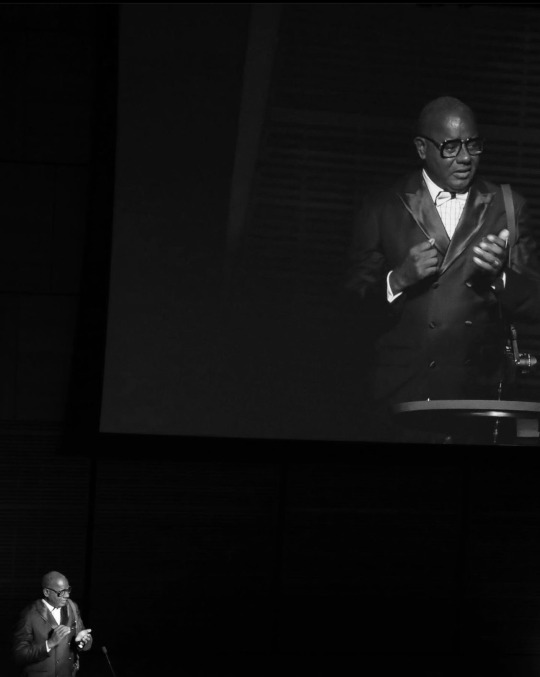
What an EPIC night, Brother Jamel Shabazz received the prestigious @luciefoundation Award presented by Peter Kunhardt, Jr. Executive Director for The Gordon Parks Foundation at Carnegie Hall… So well deserved.
Jamel Shabazz is best known for his iconic photographs of New York City during the 1980s. A documentary, fashion, and street photographer, he has authored 12 monographs and contributed to over three dozen other photography related books.
His photographs have been exhibited worldwide and his work is housed within the permanent collections of The Whitney Museum, The Brooklyn Museum, The Studio Museum in Harlem, The Smithsonian’s National Museum of African American History and Culture, The Fashion Institute of Technology, The Art Institute of Chicago and the Getty Museum.
Over the years, Shabazz has instructed young students at the Studio Museum in Harlem’s “Expanding the Walls” project, The Schomburg Center for Research in Black Culture “Teen Curator’s” program, and the Bronx Museum’s “Teen Council.” He is also the 2018 recipient of the Gordon Parks award for excellence in the arts and humanitarianism and the 2022 awardee of the Gordon Parks Foundation/Steidl book prize. His goal as an artist is to contribute to the preservation of world history and culture.
It is an honor to collaborate with Brother Jamel Shabazz on the @albeesquaremall book that has been years in the making.
Another one of Brooklyn’s Finest 👑🏆🫡 @jamelshabazz
CARTER™️ Magazine
#carter magazine#carter#historyandhiphop365#wherehistoryandhiphopmeet#history#cartermagazine#today in history#staywoke#blackhistory#blackhistorymonth#jamel shabazz
31 notes
·
View notes
Text
The importance of Donnie's location in the trailer
Call me a nerd, but when it comes to location, I go all Matpat and begin to do a research. I like to use location and some canon aspects with my fictional story, for the sake of world building.
I have a feeling Donnie is the first or second character they will focus on because hes the one in the background after the trailer ends. Also, the idw comic ended with him in a way, so it's a beautiful way to start this series
So, the location of Donnie on that train is super important for his character arc. Where is Donnie? Let's look at the picture and analyze it.

We see that inside of the underground train station, the architectural design is square shape and a bit narrow. The train stations choice of light bulbs is the linear fluorescent light bulb or, simply put, the lamp type. After some digging I found out that The New York City Subway is a rapid transit system that serves four of the five boroughs of New York City, namely : the Bronx, Brooklyn, Manhattan, and Queens
At first, I thought it was Nenvins St Brooklyn. Because there, Thearthe Shakespear was nearby. Mikey would love it there. But it didn't fit the picture at all. I hear you thinking, but what about the graffiti?
So I did a bit more digging for specifically train stations that had or still have graffiti art on the wall, and I found this

This is the Sutphin Subway entrance.

It's possible that Donnie is at Sutphin Boulevard station (IND Queens Boulevard Line) instead of Nenvin.
New York City Subway station in Queens The Sutphin Boulevard station is a local station on the IND Queens Boulevard Line of the New York City Subway. Why does this matter?
Take a look at the Google maps. We'll well well, what do we have here?

BINGO! A museum of science. It's also right next to the Zoo! We all know what happened to the Zoo animals in the movie, when Suplafly mutated. It may not be the same Zoo, but it's an interesting detail!
I live in Holland, so I am new to the train stations in NY, but I'm positive that the reason Donnie is on that train is related to the science museum. Donnie is smart and usually is the one that comes up with plans, and once he's at the science museum, he will discover his love for science and slowly become the tech genius we know and love
An honorable mention is the subway station, Washington Hights in Manhatten. This is the deepest and the most dangerous subway station tunnel. It's filled with amazing graffiti art, and I can only imagine the amazing fight scenes that could take place here.
All in all, it's just a shot in the dark because it's a theory, and I could be wrong.
19 notes
·
View notes
Text
Deco Doings - May, 2023
Spring by William Welsh, 1930. Image from Pinterest. Plattsburgh State Art Museum Origins: The Evolution of an Artist & His Craft, Selections from the Rockwell Kent Collection (In Person Event) Tuesday, November 8, 2022 – Friday, August, 11, 2023, 235 Myers Fine Arts, 101 Broad Street, Plattsburgh, NY. Museum Hours: Tuesday – Sunday Noon – 4:00 PM (EDT). New York Adventure Club Temple…
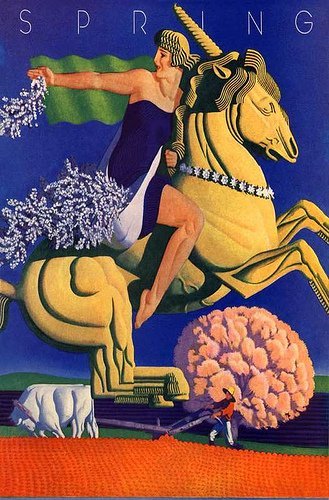
View On WordPress
#1939 New York World&039;s Fair#Art Deco#Art Deco Society of California#Art Deco Society of Chicago#Art Deco Society of Los Angeles#Art Deco Society of New York#Art Deco Society of the UK#Art Deco Society of Washington#Avalon Ball#Bronx#Bronx NY#Catalina Island#Edgard Sforzina#England#Grand Concourse#Industrial Design#Leeds#Midwood Brooklyn#New York Adventure Club#Plattsburgh State Art Museum#Radio City Music Hall#Rockefeller Center#Rockwell Kent#Society of Architectural Historians#Streamline Moderne#Temple Emanu-el#The New Deal#UK#WPA Murals
0 notes
